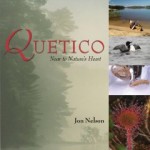Book Review: Quetico: Near to Nature’s Heart
24 Sep
 Anishinabe elders, Jon Nelson informs us in Quetico: Near to Nature’s Heart, don’t really see a distinction between the archeological past and the present when it comes to understanding a plot of land or archeological site:
Anishinabe elders, Jon Nelson informs us in Quetico: Near to Nature’s Heart, don’t really see a distinction between the archeological past and the present when it comes to understanding a plot of land or archeological site:
“All archaeological sites and the objects found within them continue to have a spiritual resonance derived from past use, and this spiritual dimension, existing in the present, makes the sites places of contemporary cultural importance.”
This blending of the past and the present seems to encapsulate Jon Nelson’s view of Quetico as well, a place he holds dear to his own heart after twelve years as a park ranger and six summers conducting archeological research. His book examines the landscape in a similarly timeless manner, reflecting not only on what lies within the park today, but also the human, geologic and ecological forces that shaped it.
Part personal essay, part history book and part textbook, Quetico: Near to Nature’s Heart examines Quetico Provincial Park through a naturalist’s lens. Nelson walks through the last century of management and protection, the shaping forces of the Glaciers and the region’s earliest explorers (the Palaeo-Indians) in a clear and easy tone. He shares his knowledge of boreal ecology and the animals of the forest, and in a unique twist, looks in detail at six park locations he considers particularly special. He delves into the geologic and human history of places like the Pickerel Lake, the Wawiag River and Prairie Portage, elucidating some of the hidden forces that made them so unique.
Quetico: Near to Nature’s Heart is to Quetico what the Naturalist’s Guide to the Arctic is to the tundra. Anyone who has been inspired to wonder about Quetico—perhaps how a great big rock ended up in the middle of a flat portage, or who wandered these portage trails first—will find a knowledgeable trail companion in Jon Nelson and his book.










